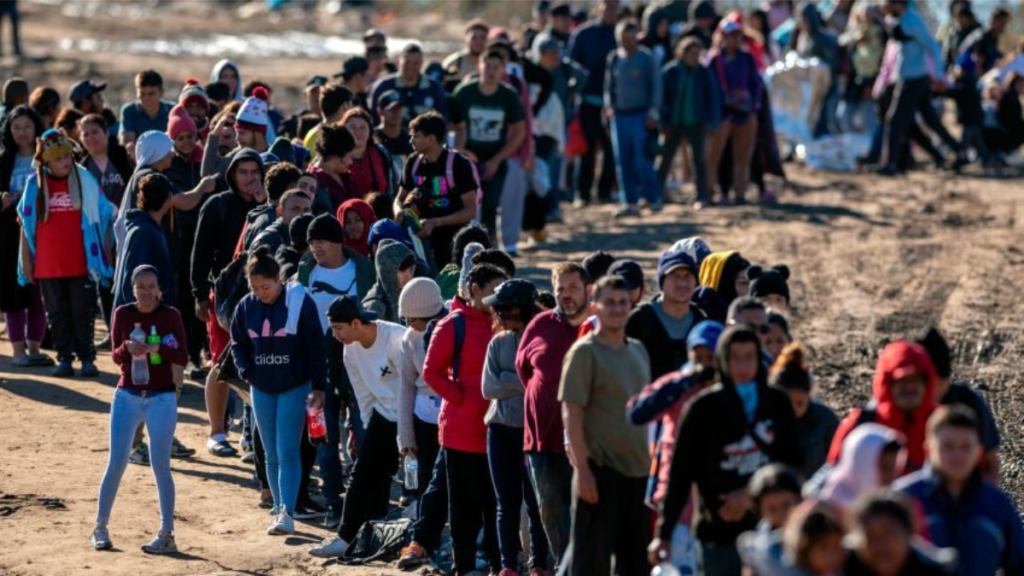The US-Mexico border crisis has escalated, with the Department of Justice (DOJ) threatening to sue Texas over its new immigration law, Senate Bill 4. This move intensifies the ongoing dispute between President Joe Biden and Texas Governor Greg Abbott over the handling of the crisis. The DOJ argues that SB 4 is preempted and violates the US Constitution, potentially hindering the federal government’s ability to enforce immigration law. The conflict extends beyond legislation, as the DOJ previously sued Texas over the state’s use of floating barriers in the Rio Grande. A temporary relief of 7,000 migrants was observed in a single day, but questions remain about the sustainability of this trend. High-level talks between US and Mexican officials have been deemed productive, with Mexico focusing on economic relations, root causes of migration, and strategies to combat human smuggling. Addressing the root causes of migration remains crucial, and the Biden administration faces political scrutiny over its handling of immigration.
Escalating Tensions: DOJ Threatens to Sue Texas
The Department of Justice (DOJ) has taken a strong stance against Texas’s new immigration law, Senate Bill 4, which grants local law enforcement the authority to arrest migrants and allows judges to remove them from the US. This move has intensified the ongoing dispute between President Joe Biden and Texas Governor Greg Abbott over the handling of the border crisis.
The DOJ argues that SB 4 is preempted and violates the US Constitution, potentially hindering the federal government’s ability to enforce immigration law. The legal threat adds to the friction between federal and state authorities, raising concerns about the impact on border security and immigration enforcement.
Floating Barriers and Legal Battles
The conflict extends beyond legislation, as the DOJ previously sued Texas over the state’s use of floating barriers in the Rio Grande. The White House condemned these measures as “incredibly extreme,” setting the stage for legal battles that continue to unfold in the courts. The outcome of these lawsuits could significantly shape future border enforcement policies.
Decrease in Apprehensions: A Temporary Relief
In a surprising turn of events, border authorities apprehended over 7,000 migrants along the US-Mexico border in a single day, marking a decrease from earlier in the month when daily apprehensions exceeded 10,000. While this presents a temporary relief for overwhelmed border authorities, questions linger about the sustainability of this trend and the factors contributing to the fluctuating numbers US-Mexico Border Crisis .
The Del Rio Sector, including Eagle Pass, Texas, witnessed approximately 2,000 border arrests on the same day. This contrasts with the previous week’s daily average of 3,000 apprehensions, signaling a notable reduction. However, challenges persist, and a senior administration official emphasized the need for continued vigilance.
Diplomatic Efforts: US-Mexico Collaboration
Amidst the crisis, high-level talks between US and Mexican officials have been deemed “productive.” The visit of Secretary of State Antony Blinken and Homeland Security Secretary Alejandro Mayorkas to Mexico City preceded a planned meeting in Washington next month. Mexican President Andrés Manuel López Obrador has taken significant steps to enhance immigration enforcement, aligning with the US’s goal of securing the border.
Mexican Secretary of Foreign Affairs Alicia Barcena highlighted the multifaceted nature of the discussions, encompassing economic relations, root causes of migration, and strategies to combat human smuggling. Mexico’s commitment to cracking down on smugglers and managing border repatriations reflects a cooperative effort to address shared challenges.
Root Causes and Future Actions
Addressing the root causes of migration remains crucial in resolving the border crisis. Poverty, inequality, violence, and family reunification emerged as key factors during the diplomatic talks. The US and Mexico acknowledged the need for a comprehensive approach to tackle these issues, emphasizing the importance of collaborative efforts.
While the recent reduction in border apprehensions provides a temporary reprieve, officials on both sides acknowledge the ongoing work required. The Biden administration faces political scrutiny over its handling of immigration, and discussions in January will assess progress and determine additional measures.
Conclusion
As the US-Mexico border crisis unfolds, the interplay between legal battles, diplomatic efforts, and border apprehensions paints a complex picture. The collaboration between the two nations is essential to finding sustainable solutions and addressing the root causes driving migration. The coming months will prove critical in shaping the trajectory of this crisis and determining the effectiveness of policy responses on both sides of the border.







